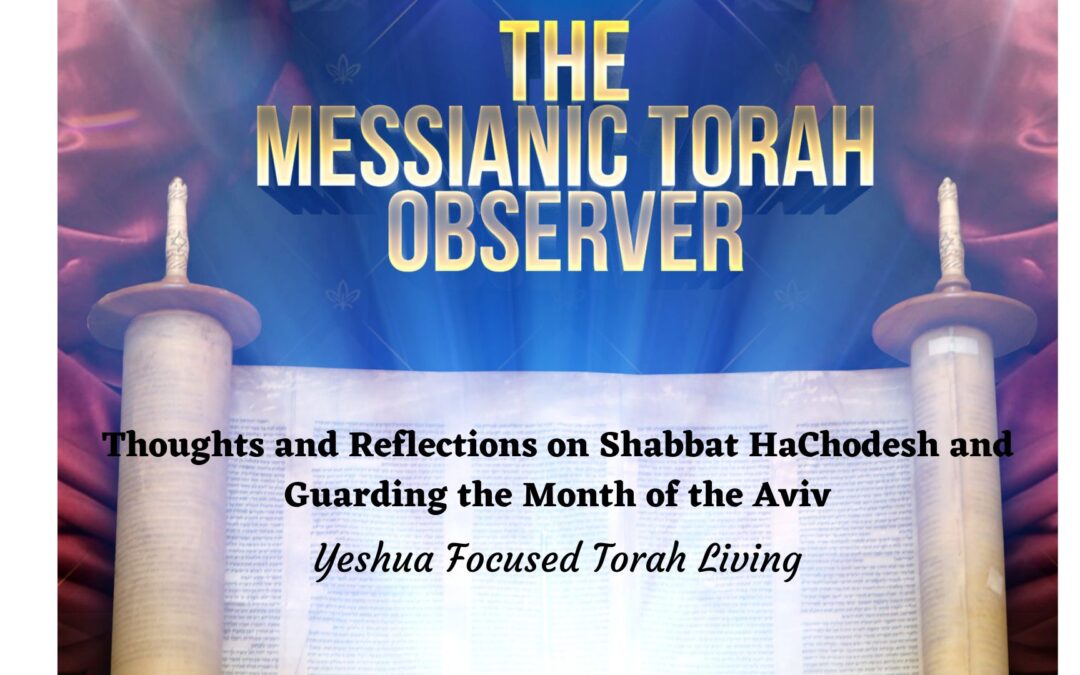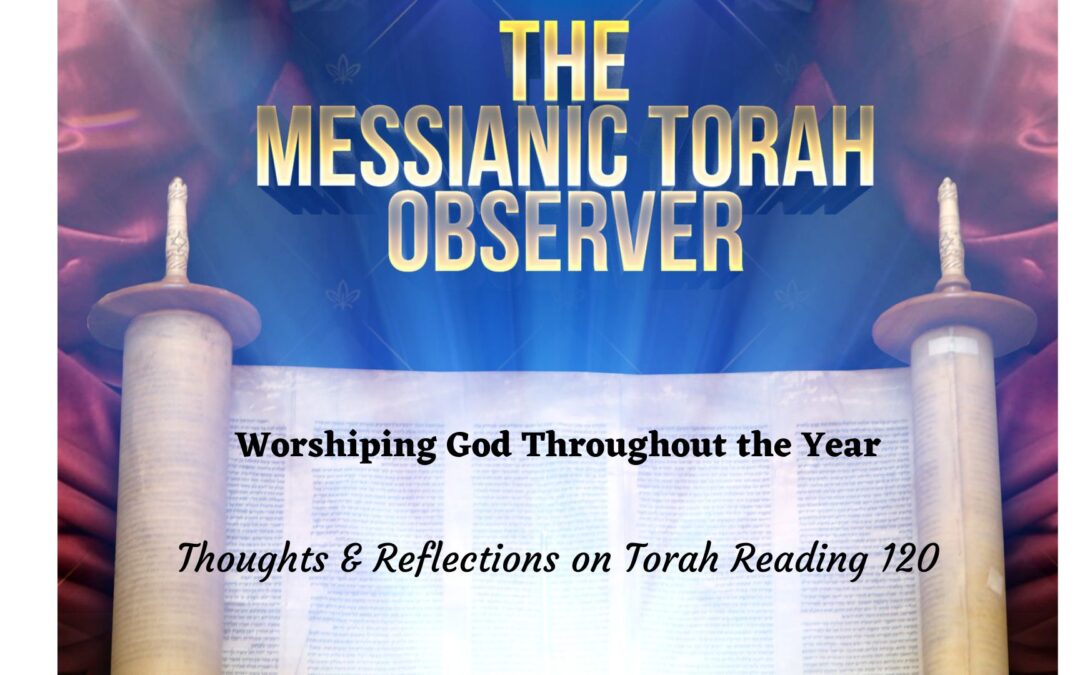Tazria (She Conceives)-Leprosy, A Shadow of Sin and the Healing Work of Messiah–Parashah-27
Parashah 27-Tazria Overview
This week’s Torah Portion (Reading) is entitled Tazria—”She Conceives.” It is found Leviticus 12:1-13:59, with the Haftarah Reading found in 2 Kings 4:42-5:19.This Torah Reading is part of an overall set of instructions on the issue of purity and impurity. Last week’s reading dealt with holiness and sanctification. We can see clearly delineated with these readings from Leviticus instructions that when followed, prepared us for worship.
There are two specific purity issues addressed in this week’s reading: (1) purification after childbirth; and (2) the law of leprosy.
Levitical Versus Hygienic
Being ritually pure and clean was required for worship at the sanctuary. This week’s reading spoke to two conditions that when manifested, precluded the affected person from worship: women having just given birth and the scourge of leprosy. Jewish scholars refer to this form of instruction as “levitical.” In simple terms, levitical means religious instruction.
Although the focus of this week’s reading provided another aspect of living a ritually clean life before YHVH, the instructions given to us by Father regarding postpartum conditions and skin diseases had direct hygienic application for the entire community as well. Containing the spread of infection was vital to ensure the overall wellbeing of the community. Thus Father’s grace and love for the nation is brilliantly displayed His giving of these instructions.
Neither the hygienic or the levitical perspective of these instructions is mutually exclusive of the other. That is, the levitical does not exclude the hygienic and vice versa. For it is only commonsense that Father’s demand that His people be in a state of ritual purity at any given time also ensures proper hygiene is maintained within the community.
What is that old adage? Cleanliness is next to Godliness? No truer words can be spoken.
Leprosy Focus
I’ve elected to focus on chapter-13 of Leviticus in this week’s portion which deals with leprosy.
Leviticus 13 deals exclusively with the scourge of leprosy. Verses 9-17 relate to the diagnosing of the disease.
What is Leprosy?
Today, leprosy is known as Hansen’s Disease (HD). It is described ass an infection that is caused by the bacteria Mycobacterium Leprae or Myobacterium Lepromatosis. (Wikipedia)
According to the CDC, the disease can affect a person’s eyes, nerves, skin and the lining of the nose. Today the disease is curable.
Symptoms include:
- Growths on the skin;
- Thick, stiff or dry skin;
- Ulcers on the soles of the affected person’s feet;
- Swelling or lumps on the face;
- Loss of eyebrows or eyelashes;
- Numbness of the affected areas of skin;
Muscle weakness or paralysis of the hands and feet;
- Eye problems leading to blindness; nose bleeds;
- And blindness.
The disease is spread by airborne droplets (CDC).
According to Leprosy Mission, there are more than 200,000 new cases of Hansen’s Disease reported each year worldwide, with some 3-million people living with the irreversible disabilities the disease causes when left untreated.
What we know today as leprosy is not exactly what the Bible reports as leprosy. Our present day form of leprosy, aka Hansen’s Disease, can be said to be inclusive of the Biblical form of the disease. For biblical leprosy probably encompassed a panoply of infectious skin diseases.
Pertinent Verses of the Reading
Lev. 13:10—”And the priest shall look, and, behold if there be a white rising in the skin, and it have turned the hair white, and there be quick raw flesh in the rising…” (JPS).
According to J. H. Hertz (Torah and Haftorah), “in the disease of elephantiasis one of the early manifestations is the growth of vesicles of a glistening white hue, which burst and discharge a whitish fluid.”
Lev. 13:11—”…it is an old leprosy in the skin of his flesh, and the priest shall pronounce him unclean; he shall not shut him up; for he is unclean” (JPS).
This verse describes the confirmation of leprosy whereby a Levitical Priest would confirm that the disease “is definitely established as rooted in the system by the presence of quick raw flesh and white hair. No preliminary isolation is necessary; it is a clear case of uncleanness” (Hertz).
Verses 12-17 of the 13th chapter of Leviticus “refer to common white leprosy. It is less serious than elephantiasis or leprosy proper. The health of the person remains normal during the time the malady persists, and it generally passes off after a while. There is only discoloration of the skin in this milder form of infection” (Hertz).
So it seems that the “leprosy” that this Torah Portion is addressing (as mentioned above) covers a panoply of infectious skin conditions; not confined to Hansen’s Disease form of skin ailment that exists today.
Lev. 13:45—”And the leper in whom the plague is, his clothes shall be rent, and the hair of his head shall go loose, and he shall cover his upper lip and shall cry: ‘Unclean, unclean’” (JPS).
According to Hertz, the term leper “is in the masculine; the female sufferer also left the camp and lived apart, but was not required to tear her garments and uncover her head. The customs of the leper are those of a mourner. He was to regard himself as one upon whom death had laid its hand. He was a living death, not only in the physical sense, as suffering from a loathsome and lingering disease; but also in the spiritual sense, as cut off from the life of the Community of Israel.” The cry “unclean—unclean” was to “warn people from touching them. In later times, lepers wore a bell for the same purpose.”
Lev. 13:46—”All the days wherein the plague is in him he shall be unclean; he is unclean; he shall dwell alone; without the camp shall his dwelling be” (JPS). The term “alone” as used in this verse is better expressed as “apart.”
Lev. 13:52—”And he shall burn the garment, or the warp, or the woof, whether it be of wool or of linen, or any thing of skin, wherein the plague is; for it is a malignant leprosy; it shall be burnt in the fire” (JPS).
The Haftarah Thazria as found in 2 Kings 4:42-5:19 documents two-stories involving the Prophet Elisha: (1) “during the great famine, the scanty bread of a poor man’s offering is multiplied so that Elisha is enabled to feed a hundred of the ‘sons of the prophets;’” and (2) the curing from leprosy of the captain of Syria’s host by the Prophet Elisha.
If we look at leprosy from a spiritual cause and effect standpoint, it ultimately came about because of sin. In fact, leprosy was viewed as a curse of God.
Leprosy is mentioned some 68-times in the AV (some 55-times in the Old and 13-times in the New).
Leprosy from a Spiritual Standpoint
Many bible scholars contend that leprosy in general was not a fatal disease in the days of the bible. However, I would side with J. H. Hertz on the fatal nature of the disease in both the times of the New and Old Testaments. I submit that the mandated social ostracizing that the disease engendered caused many of those affected to perish. It stands to reason that the affected’s care generally had to come from the unaffected (ie., family members and friends had to provide food and other life-provisions to the affected given the affected member’s persona non grata status in the community).
And we must not overlook the psychological harm that would naturally come from being ostracized from society because of the hygienic and levitical restrictions incumbent upon affected persons. The infected would naturally feel abandoned and useless at some point, which would lead most down the path of neglecting their own care.
Leprosy and Sin
For Yeshua-centric Torah observers such as ourselves, leprosy is analogous to sin. Like leprosy, which begins small and in some cases even innocuously, sin has the great potential of ultimately spreading and growing out of control in a believer’s life causing him/her to become unclean before YHVH. Paul wrote:
“Your boasting is not good. Do you not know that a little leaven leavens the whole lump” (1 Cor. 5:6;ESV; cf. Gal. 5:9).
Thus, non addressed sin ostracizes the offender from YHVH. As a result, the offender’s prayers and worship may not be accepted nor heard by Father. If the offender’s sin is known to others in the Faith Community, they may be asked to leave community. And until the offender repents and turns from their wicked ways, he/she is essentially unclean and ostracized from both the community and YHVH.
Paul wrote:
“Do not be deceived: God is not mocked, for whatever one sows, that will he also reap. For the one who sows to his own flesh will from the flesh reap corruption, but the one who sows to the Spirit will from the Spirit reap eternal life” (Gal. 6:7,8; ESV).
We know from Deuteronomy 28:15-68 that sin and failure to obey YHVH’s commands can result in a whole host of curses and general problems that spiritually echo the scourge of leprosy.
So in the case of physical leprosy, the priest examines and makes a determination as to the affected being clean or unclean. Cleansing is required at the terminus of the assessment. Being deemed clean by the priest brings the once affected back into a right-standing with society and YHVH and he/she is permitted to resume worship and is welcomed back into the community.
Analogously speaking, when the least spot of sin appears in our life, we must turn to our priest—Y’shua Messiah–for his/her assessment and determination. He, through the working of the Holy Spirit, will determine what happens to us and the course of action we must take in order to be restored to a right-relationship with YHVH and our Faith Community.
Matthew 8:1-4 documents the story of Y’shua healing a leper which is analogous to His undeniable role in our being ruled as clean before a holy and righteous God.
What I find most interesting about the story of the cleansing of the leper by Yahoshua is the instruction that Master gave the healed man:
“See thou tell no man; but go thy way, shew thyself to the priest, and offer the gift that Moses commanded, for a testimony unto them” (KJV).
Even as the walking, talking Torah, our Master in no way violates Torah, but instructs the healed man to keep every aspect of Torah related to his condition.
Healing Through Yahoshua our Messiah
Thus, Yeshua can heal the sin-sick soul and thus we become clean and can remain in right-standing before a holy God. Back in the day, leprosy could only be healed through divine intervention. Carry this same thinking on over to sin. Yeshua is the only means by which we may be healed from the existential ravages of sin. He is the only sanctioned means of clearing us and deeming us clean before our Heavenly Father.
Let us come to Him and have our situation assessed. Then let us take immediate and purposed actioned to addressed the problem.
The difference to be had here, of course, is that our High Priest (contrary to the Levitical Priest of our forefathers) cannot only deliver us from physical disease, but He can also deliver us from the ravages of sin.
Shabbat Shalom Dear Saint.
Until next week.

Shabbat HaChodesh and Guarding the Month of the Aviv Thoughts and Reflections
Shabbat Shalom beloved of Yeshua Messiah. I pray that this post finds you, your families, and your fellowships well and blessed on this hurried but expectant Preparation Day. 12 And יהוה spoke to Mosheh and to Aharon in the land of Mitsrayim, saying, 2“This new...
The High Expectations for God’s People to Fulfill His Will and Purpose — Thoughts and Reflections on Torah Reading 122
Shabbat Shalom beloved of Yeshua Messiah. This week's Torah Reading is the 122nd reading of our 3-year Torah Portion reading cycle. Our reading is found in Numbers 32:1-42. I’ve entitled this teaching: The High Expectations for God's People to Fulfill...
What God Expects From Us When We Make Vows — Thoughts and Reflections on Torah Reading 121
Shabbat Shalom beloved of Yeshua Messiah. This week's Torah Reading is the 121th portion of the 3-year Torah Portion reading cycle. Num 30:1-31:54 contains this week's Torah Reading. I’ve entitled this teaching: What God Expects from us When We Make Vows...

Worshiping God Throughout the Year — Thoughts and Reflections on Torah Reading 120
Shabbat Shalom beloved of Yeshua Messiah This week's Torah Reading is the 120th portion of the 3-year Torah Portion reading cycle. Num 28.1-29.40 contains this week's Torah Reading. I’ve entitled this teaching: Worshiping God Throughout the Year — Thoughts and...
The Generational Inheritance Covenant Realized — Thoughts & Reflections on Torah Reading 119
Shabbat Shalom beloved of Yeshua Messiah. This week's Torah Reading is the 119th portion of the 3-year Torah Portion reading cycle. Num 26:52-27:23 contains this week's Torah Reading. In last week's reading, Abba instructed Moshe to conduct a census of...
Learning to Fear God and Receive His Peace — Israel’s Inextricable Link to Our Salvation Part 4
After Paul’s conversion to the Way Faith, the Nazarene assemblies that were strewn throughout the Judean region, including the Galilee and Samaria, enjoyed a season of relative peace and unity. (Act 9:31) Those coming into the Way Movement, a movement that many...
The Call For God’s People to be Jealous with His Jealousy — Thoughts and Reflections on Torah Reading 118
And greetings elect of the Most High. Welcome back to the Messianic Torah Observer. I’m Rod Thomas, coming to you on Preparation Day, the 21st day of the 11th month of Yah’s biblical calendar year. That translates into 2/2/2024 on the pagan Roman Calendar....
Our God’s Blessings and Promises are Irrevocable — Thoughts and Reflections on Torah Reading 117
Greetings! Shabbat Shalom saints of the Most High. It is the 15th day of the 11th biblical calendar month and the 27th day of the 1st month of the Roman calendar year of 2024. I pray, trust, and hope that this week’s Thoughts and Reflections find you, your families,...
There’s a Little Balaam in All of Us–Thoughts and Reflections on Torah Reading 116
Shabbat Shalom saints of the Most High. It is the 8th day of the 11th biblical calendar month and the 20th day of the 1st month of the Roman calendar, 2024. I pray, trust, and hope that this week’s thoughts and reflections find you, your families, and your fellowships...
Nobody Told Me That the Road Would Be Easy, but He Didn’t Bring Me This Far To Leave Me–Thoughts and Reflections on Torah Reading 115
Greetings Saint of the Most High. Coming at you on this cold Sabbath morning in the DFW, on the first day of the 11th biblical calendar month, trusting and hoping that these Thoughts and Reflections on Torah Reading 115 find you, your family, and your fellowship is...


0 Comments